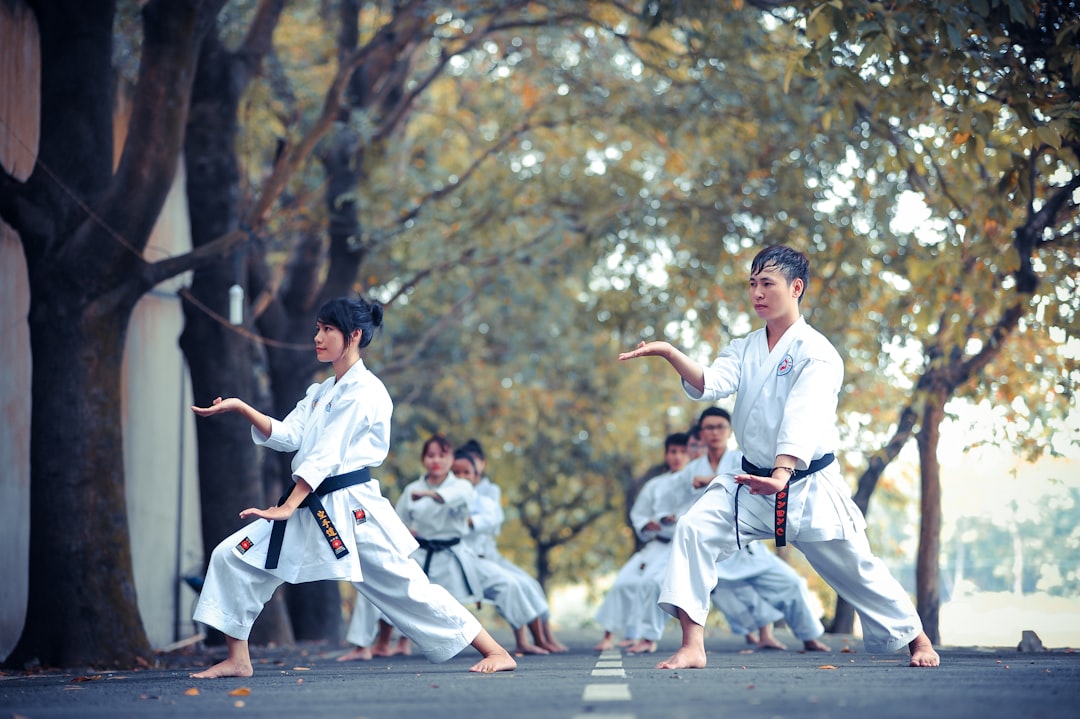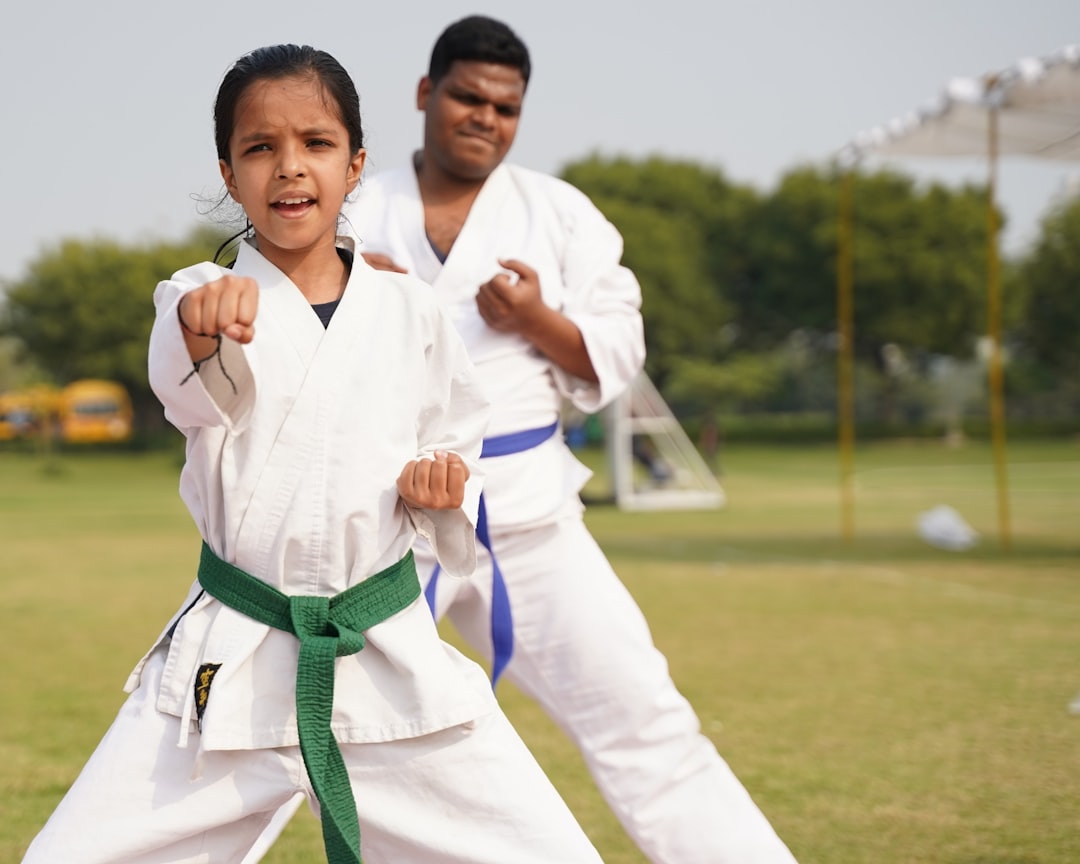The karate outfit, known as a Gi, is a traditional attire central to karate practice, symbolizing discipline and respect. It consists of a jacket, trousers, and belt, with variations among different karate styles like Shotokan, Goju-Ryu, and Wado-Ryu. The Gi's universal elements remain consistent, with functional designs that facilitate movement and training. The jacket comes in long or short sleeves, while the trousers are longer and designed for flexibility. The belt, beyond its practical use, indicates the practitioner's rank. The Gi's simplicity and significance transcend mere attire to represent tradition, honor, and dedication within the karate community. When selecting a Gi, it's important to consider comfort, fit, and durability, ensuring optimal movement during practice. The Gi's origins date back to Okinawa, where it evolved from practical island attire to an internationally recognized uniform, reflecting both its cultural heritage and adaptability to modern athletic needs. Today's karate outfits incorporate innovation for enhanced performance while retaining the iconic elements of the traditional gi, integrating modern athletic technology to maintain high-performance standards in this traditional martial art.
Karate practitioners around the globe are familiar with the traditional garb they don during practice and competition. Known colloquially as a “karate outfit,” this attire, specifically the Gi, serves as both a uniform and a tool for training. This article delves into the essence of the karate Gi, exploring its traditional elements, sizing considerations, historical evolution, and contemporary adaptations. From understanding the significance of the top, bottoms, and belts to recognizing how the Gi has journeyed from its origins in Okinawa to its modern variations, readers will gain insight into what constitutes a true karate outfit called.
- Understanding the Traditional Karate Outfit: The Gi
- Components of a Karate Gi: Top, Bottoms, and Belts
- Selecting the Right Size and Fit for Your Karate Gi
- The Evolution of the Karate Uniform: From Okinawa to Today
- Modern Adaptations: Non-Traditional Karate Outfits for Training and Competition
Understanding the Traditional Karate Outfit: The Gi

When delving into the realm of traditional martial arts, one encounters various terms and garments, chief among them being the karate outfit known as the Gi. The Gi is a fundamental component of a practitioner’s attire in karate practice, embodying both practicality and tradition. Constructed from sturdy cotton or hemp fabric, the Gi consists of a jacket, trousers, and belt, with the latter serving to denote rank through different colors. Are the dimensions and design of the Gi consistent across different styles of karate? While there may be slight variations in cut and style among Shotokan, Goju-Ryu, or Wado-Ryu practitioners, the essential elements of the Gi remain uniform. The top, a jacket with long or short sleeves, is buttoned up the front, and the trousers are designed to facilitate mobility and comfort during rigorous training sessions. What distinguishes the Gi in different karate styles is often the collar height, sleeve length, and trouser fit, which can be tailored to reflect each style’s specific requirements or personal preferences of its practitioners. Whether one practices Shotokan, Goju-Ryu, or any other traditional form of karate, the Gi serves as a symbol of discipline, respect, and tradition that transcends the individual styles.
Components of a Karate Gi: Top, Bottoms, and Belts

When engaging in karate, practitioners don the traditional karate outfit, often referred to as a Gi. The Gi is a garment that epitomizes both the discipline and respect inherent to the martial art. A typical Gi consists of three main components: the top, the bottoms, and the belt, each serving a distinct purpose. The top, which is known as the “Uwate,” is a jacket that reaches just beyond the hips, typically made of heavy cotton or hemp fabric, offering both durability and comfort during practice. It features a front split opening and is designed to allow for a full range of motion without compromising on modesty. The bottoms, termed “Shin-gi,” are wide-legged trousers that provide the necessary mobility for practitioners to execute their techniques effectively. They are usually secured with drawstrings at the waist for a proper fit and are designed to be slightly longer than the average pant length, often requiring a special break to achieve the traditional look. Completing the ensemble is the belt, or “Obi,” which is both functional and symbolic. It is tied around the waist and serves to secure the Gi in place during practice, while also representing the rank of the practitioner within the karate discipline. The choice of belt color is indicative of the wearer’s level of skill and experience, ranging from white for beginners to black for advanced practitioners, each color signifying different stages of progression and mastery in karate. What differentiates the Gi from other martial arts uniforms is not only its simplicity and functionality but also the profound respect it commands as a symbol of tradition and honor within the karate community.
Selecting the Right Size and Fit for Your Karate Gi

When preparing for a karate practice or competition, selecting the appropriate karate outfit, commonly referred to as a Gi, is crucial for both functionality and respect for the martial art’s traditions. The right size and fit of your Gi can significantly impact your performance and comfort during training sessions. A Gi that is too large may hinder your movements, causing you to lose balance or maneuverability, while one that is too tight can restrict your range of motion and cause discomfort. Therefore, what is the ideal size for a karate Gi? It should fit snugly without being overly tight, allowing for a full range of motion without being constrictive. The sleeves should reach just past the wrist with the hands at the sides, and the pants should be hemmed so they break slightly above the ankle. Additionally, the jacket length should extend to the mid-thigh, ensuring that when you perform certain moves, such as a kamae stance, your Gi does not ride up or hinder your posture. Selecting a Gi with the correct size and fit is not just about adhering to traditional standards but also about optimizing your karate practice for both comfort and performance. What’s more, the material of the Gi should be breathable yet durable, providing flexibility during dynamic movements while withstanding the wear and tear that comes with regular training. Remember, a well-fitted Gi is an investment in your martial arts journey, enabling you to move with ease and focus on perfecting your techniques.
The Evolution of the Karate Uniform: From Okinawa to Today

When delving into the origins of modern karate practice, one must first consider the historical context from which it emerged. Traditionally, practitioners in Okinawa, an island with a rich history of martial arts, wore garments that facilitated movement and protected the wearer. These early attire were based on the functional clothing of the Ryukyu Kingdom, known today as Okinawa. Over time, as karate was refined and formalized, the need for a uniform that allowed for full range of motion and was standard across different schools became apparent. What is now recognized as the classic karate outfit, or “keikogi,” evolved from these earlier garments. This keikogi typically consists of a jacket and trousers made of light cotton fabric, designed to be both durable and comfortable for rigorous training sessions.
The evolution of the karate outfit is a testament to the adaptability of traditional martial arts attire. As karate spread beyond Okinawa’s shores and crossed cultural boundaries, so too did its uniform. The keikogi underwent modifications to suit different climates and training environments. Today, while the traditional white keikogi remains a staple in many dojos, variations such as the judogi, which is used in judo, have also been adapted for karate practice. These variations often include additional features like reinforced knees and elbows to protect the practitioner during sparring or kata demonstrations. What began as practical attire in a distant island has thus become an internationally recognized uniform, symbolizing discipline, respect, and the enduring legacy of karate’s rich history.
Modern Adaptations: Non-Traditional Karate Outfits for Training and Competition

When delving into the realm of martial arts, one may be curious about the specific attire that practitioners wear. A karate outfit, known as a gi, is traditionally donned by karateka during practice and competition. However, in recent years, modern adaptations of this traditional garb have emerged to cater to the evolving needs of training and competition. These non-traditional karate outfits are designed to offer greater flexibility, comfort, and durability for the demands of contemporary martial arts practice. Are these modern karate outfits effective for both training and competition? The answer is affirmative; they are tailored to meet the high-performance standards required in competitive settings while still maintaining a level of tradition. For instance, some karate outfits now incorporate moisture-wicking fabrics that keep the athlete cool and dry during intense training sessions. Additionally, these outfits often feature a more streamlined design, allowing for a full range of motion without compromising on the essential aspects of the traditional gi, such as the jacket and pants being secured with belts denoting rank. These innovations ensure that practitioners can focus on their techniques and performance without being hindered by their attire. As a result, the evolution of the karate outfit reflects the sport’s adaptation to modern athletic demands while still honoring its rich historical roots.
In conclusion, a karate outfit, commonly known as a Gi, serves as both a cultural symbol and a practical garment for practitioners of this ancient martial art. Its components—consisting of the top, bottoms, and the belt, each carrying its significance—have remained largely consistent over time, reflecting the rich tradition from Okinawa that has evolved into a global phenomenon. As karate continues to grow in popularity, the selection of the right size and fit for one’s Gi becomes increasingly important, ensuring comfort and proper form during practice and competition. While adaptations in material and design have emerged to cater to modern training needs and varying climates, the essence of the traditional Gi remains a cornerstone in the world of karate, representing respect, discipline, and tradition. Whether you are an enthusiast or a seasoned martial artist, understanding what constitutes a karate outfit called a Gi is essential for embracing this timeless practice authentically.
